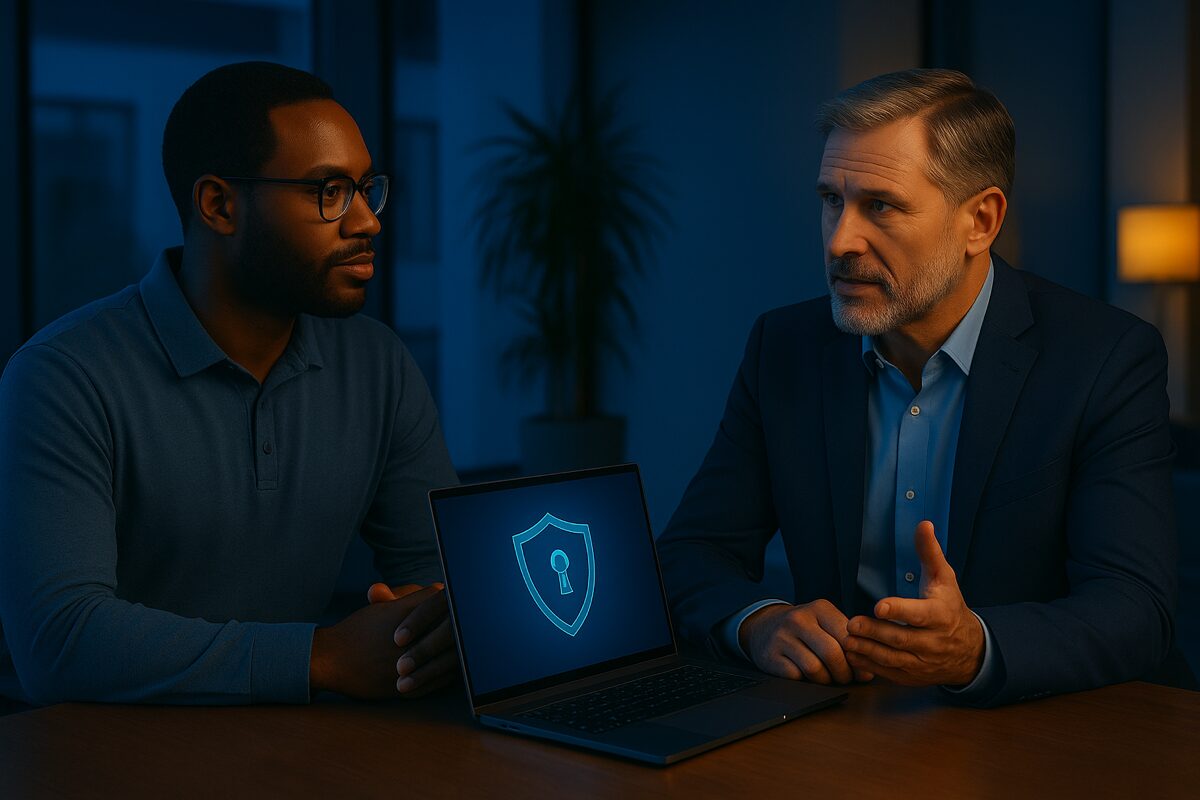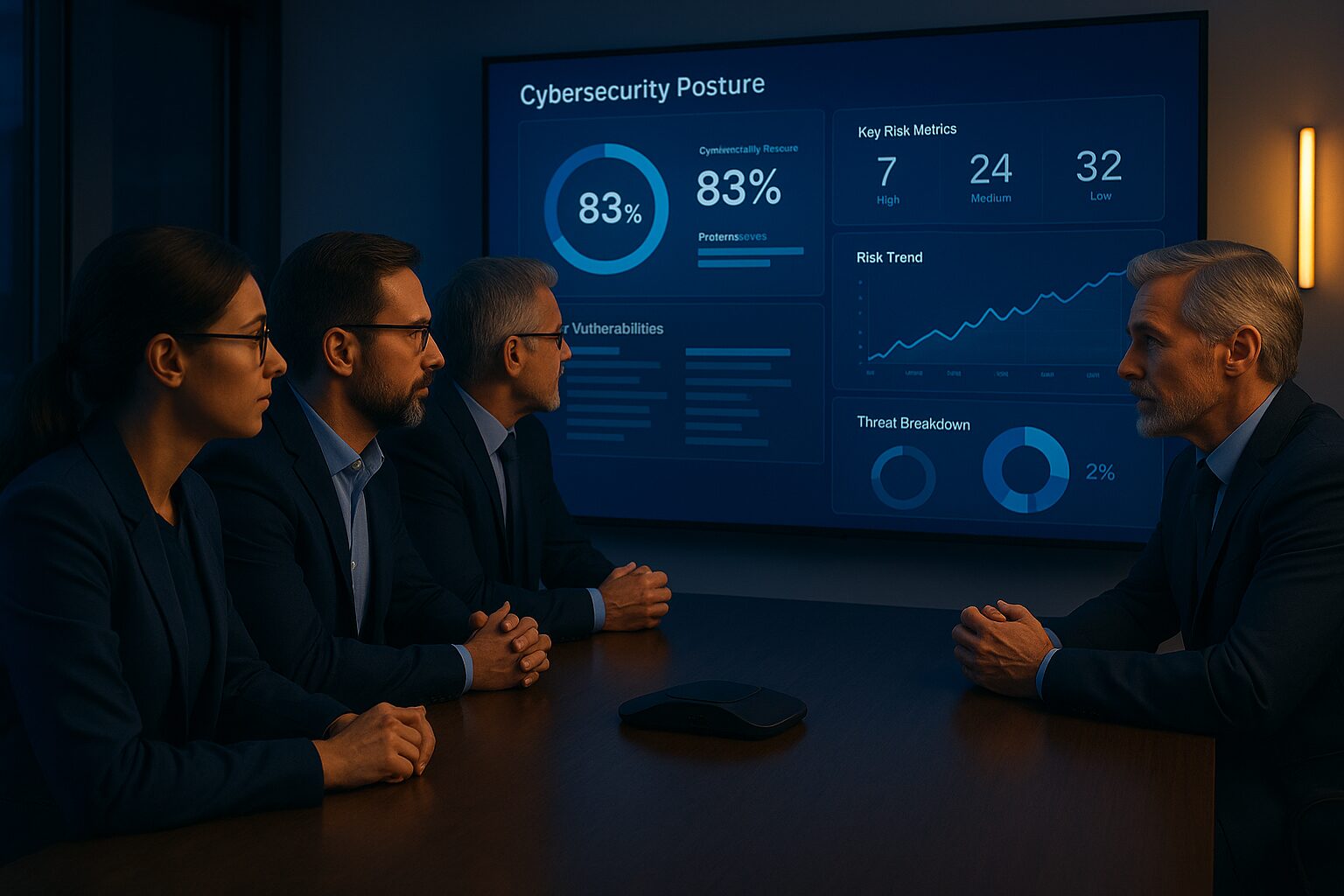Cybersecurity is no longer just an IT problem—it’s a business risk. And for mid-market organizations juggling growth, compliance, and digital transformation, that risk is growing faster than internal teams can manage.
A Virtual Chief Information Security Officer (vCISO) offers leadership-level cybersecurity guidance without the full-time cost. But how do you know when your organization is ready—or overdue—for one?
Let’s walk through the signs, scenarios, and strategic benefits of bringing in a vCISO, with real-world triggers drawn from industries like healthcare, finance, and professional services.
What Is a vCISO?
A Virtual CISO is a senior security leader (often fractional or contract-based) who provides executive-level oversight of your cybersecurity posture. Unlike a one-off consultant or outsourced MSSP, a vCISO acts as a long-term strategic partner—working with your board, your IT team, and your compliance stakeholders.
Core Responsibilities:
- Security program development and oversight
- Cyber risk assessments and audit readiness
- Regulatory compliance (HIPAA, SOC 2, FTC Safeguards Rule)
- Security roadmap development
- Incident response planning
- Board and executive reporting
A vCISO brings C-level strategy without the full-time executive overhead—making them ideal for mid-sized businesses and multi-location organizations that need executive vision, fast.
Signs It’s Time to Hire a vCISO
In today’s threat landscape, the question isn’t if your organization will face cybersecurity pressure—it’s when, and from where. For many mid-sized businesses, signals of rising risk show up quietly at first: a missed audit deadline, a sudden uptick in phishing attempts, or a vendor questionnaire that takes days to answer. Over time, these signals compound into systemic strain on your internal IT team. That’s when a virtual Chief Information Security Officer (vCISO) stops being a luxury—and becomes a necessity. If you’re wondering whether now is the time to bring in strategic security leadership, start by asking: are any of these symptoms showing up in your organization?
1. You’re Facing Increasing Regulatory Pressure
If HIPAA, PCI DSS, or the FTC Safeguards Rule keeps you up at night, you’re not alone. Many businesses in healthcare, financial services, and retail face growing compliance burdens—with serious penalties for missteps.
A vCISO helps interpret, implement, and stay ahead of evolving requirements. They create policies, ensure technical controls are in place, and guide your team through audits and assessments with confidence.
US Stat Insight: According to HHS, 2023 saw over 133 million individuals affected by healthcare data breaches—a record high.
Talk to a Security Strategist
2. Security Incidents Are Becoming More Frequent
Have you noticed more phishing emails slipping through filters, suspicious logins appearing in reports, or employees accidentally clicking malicious links? Even if these incidents haven’t yet caused a major breach, a pattern of small events is one of the clearest early warning signs of systemic risk. In today’s landscape, attackers often test defenses quietly—probing for misconfigurations, weak passwords, or unpatched systems before launching a larger attack.
A vCISO recognizes these patterns for what they are: early indicators that your organization’s security posture needs reinforcement. They help implement structured incident response frameworks like NIST or ISO 27035, ensuring your team knows exactly how to react when something happens. That includes clear escalation paths, communication plans, and predefined actions to contain and recover from threats.
Just as importantly, vCISOs bring proactive measures to reduce dwell time—the amount of time an attacker remains undetected in your systems. According to IBM’s 2024 Cost of a Data Breach Report, organizations that detected and contained incidents within 30 days saved over $1.7 million compared to slower responders. A vCISO can help you achieve that speed by building detection workflows, running tabletop exercises, and overseeing continuous monitoring programs.
Beyond the technical playbook, a vCISO adds what most internal teams lack: strategic oversight. They review patterns in your incident logs, identify recurring weaknesses, and prioritize fixes that will have the greatest impact—whether that’s tightening access controls, upgrading endpoint protection, or improving user awareness training.
Small incidents often signal deeper vulnerabilities. A phishing attack that bypasses filters could reveal poor email authentication settings; a malware alert might uncover unpatched software or insufficient segmentation. A vCISO doesn’t just treat the symptom—they uncover and address the underlying cause, helping you turn reactive firefighting into structured resilience.
3. The Board Is Asking More Questions
If your board or executive team is starting to ask questions like:
- “What’s our ransomware risk?”
- “Do we have cyber insurance?”
- “What happens if we get hit next week?”
…it’s a clear signal that cybersecurity is no longer seen as just an IT issue — it’s a business risk. And leadership wants answers that are strategic, not technical.
This is where a vCISO proves invaluable. They sit at the intersection of security and business, translating technical threats into financial and operational impact. Instead of drowning executives in firewall logs and patch reports, they deliver risk-based dashboards, quantified exposure metrics, and scenario modeling that help your board understand what’s truly at stake.
A vCISO can also lead cyber insurance readiness efforts—ensuring the policies, controls, and documentation are in place to qualify for coverage (and avoid denials during a claim). And when a board member inevitably asks, “How fast could we recover?”, your vCISO brings a clear incident response plan and recovery time estimate that inspires confidence.
As security questions rise to the board level, it’s not enough to report on what’s been done. You need someone who can speak in terms of risk reduction, cost avoidance, and regulatory posture—someone who knows how to frame cybersecurity in the language of decision-makers.
4. Security Questionnaires Are Slowing Down Sales
If enterprise sales cycles are getting stuck in security review purgatory, you’re not alone. More companies—especially in finance, healthcare, and SaaS—are demanding detailed risk assessments before signing contracts. These security questionnaires can span 200+ questions, and if your team is scrambling to respond or losing deals because answers aren’t standardized, that’s a red flag.
A vCISO can dramatically reduce friction in your sales process by:
- Creating a centralized security documentation library that can be quickly adapted per client.
- Mapping your environment to recognized frameworks like SOC 2, ISO 27001, or NIST CSF to demonstrate maturity and instill confidence.
- Helping you anticipate what enterprise buyers want to see—from MFA policies to business continuity plans—so you can proactively deliver them.
They also play a critical role in aligning your security posture with go-to-market strategy. In B2B environments, a mature cyber program isn’t just a risk reducer—it’s a sales enabler.
With a vCISO’s guidance, you can turn security from a bottleneck into a competitive advantage, ensuring your sales and legal teams can move quickly through security reviews without guesswork or delays. When risk concerns are off the table, deals close faster.
5. Your IT Director Is Drowning
At many mid‑sized organizations, “IT” is still treated as a single department — or worse, a single person — responsible for everything from resetting passwords to managing firewalls to planning next year’s cloud migration. It’s an impossible balancing act. The result is predictable: constant firefighting, strategic initiatives getting postponed, and critical security decisions being made reactively instead of intentionally.
When the IT director spends most of their week troubleshooting connectivity issues or helping users recover lost files, there’s little time left to focus on risk management, policy development, or incident preparedness. Yet those are exactly the areas where organizations face the most exposure. A vCISO steps in to close that gap — not by replacing your IT leader, but by freeing them to focus on infrastructure and operational performance while cybersecurity strategy is managed by a seasoned expert.
A vCISO brings the governance, structure, and forward planning that most internal teams can’t maintain under day‑to‑day pressure. They oversee vulnerability assessments, compliance readiness, and security roadmap execution, while collaborating closely with your IT director to align technical priorities with business risk. This partnership transforms your IT function from reactive support into a proactive, strategic engine.
The benefit isn’t just reduced burnout — it’s organizational resilience. With a vCISO owning the security vision, your IT director can finally focus on modernizing systems, improving uptime, and enabling innovation without the constant anxiety of “what if we get breached?” hanging overhead. It’s a smarter division of labor for a more complex digital age.
Explore Fractional IT Leadership
6. Your Cyber Insurance Premiums Are Skyrocketing
Cyber insurance used to be a simple checkbox. Today, it’s a battleground. As ransomware attacks surge and regulatory scrutiny intensifies, carriers are tightening underwriting standards and dramatically raising premiums. It’s not uncommon for businesses to receive renewal quotes with 50–100% increases — or worse, face reduced coverage despite paying more.
What changed? Insurers now demand proof that you’ve implemented specific cybersecurity controls: multi-factor authentication (MFA), endpoint detection and response (EDR), incident response (IR) plans, regular risk assessments, and even employee training programs. Without them, your organization is deemed too risky to insure — or left paying a small fortune for limited protection.
This is where a vCISO becomes invaluable. They bring the strategic oversight to:
- Align your cybersecurity posture with insurer requirements
- Document and demonstrate control implementation
- Proactively reduce your cyber risk score
- Advocate for more favorable terms and coverage
In short, a vCISO translates risk into language insurers understand — and makes you a better candidate for coverage. Some Meriplex clients have even reduced premiums after bringing in a vCISO to close gaps and formalize policies.
And here’s the kicker: even if you’re not planning to file a claim, insurers are increasingly requiring security attestation just to approve vendor contracts. If you can’t meet the bar, you may lose business — especially in regulated industries like healthcare, finance, or legal services.
A vCISO doesn’t just help you get covered — they help you stay competitive.
7. You Don’t Know What You Don’t Know
Sometimes, the most dangerous cybersecurity risk is uncertainty. If your leadership team can’t confidently answer questions like:
- “What are our top vulnerabilities right now?”
- “Do we have proper MFA, EDR, and backup strategies in place?”
- “Would we know if a breach happened—and what would we do next?”
…you’re not alone. This is common in mid-sized organizations juggling day-to-day operations with limited security expertise.
A vCISO doesn’t just fill in the blanks—they help define the questions. They conduct baseline risk assessments, review your tech stack for misconfigurations or shadow IT, and audit your incident response and business continuity plans. In doing so, they bring clarity where there’s confusion and control where there’s chaos.
This kind of expert visibility is critical—not just to prevent threats, but to prioritize the right actions based on business impact. Without it, you could be overspending on tools while underprotecting your most critical assets.
In essence, a vCISO gives your team a flashlight in the fog—turning ambiguity into assurance.
Talk to a Security Strategist
Engagement Models: How vCISO Services Work
Virtual CISO services are designed to be flexible, cost-effective, and scalable to match the evolving needs of mid-market organizations. Whether you’re looking for executive-level strategy, hands-on policy development, or help preparing for an audit, a vCISO engagement can be tailored to your operational maturity and internal capacity.
Typical Engagement Models
- Monthly Retainer (Ongoing Partnership)
This is the most common model for companies that want part-time executive oversight without hiring a full-time CISO.
A monthly retainer typically includes:
- Strategic security roadmap creation and ongoing updates
- Regular risk assessments and board-ready reporting
- Policy development and compliance alignment (e.g., HIPAA, SOC 2, FTC Safeguards Rule)
- Team advisory and coordination with IT and legal
It’s ideal for organizations that want long-term support with predictable costs and executive-level continuity.
- Project-Based (Short-Term or Tactical Needs)
Need help preparing for an audit? Just discovered a breach? This model is perfect for targeted, high-impact deliverables.
Typical use cases include:
- Cybersecurity audit preparation or remediation
- Incident response plan creation or tabletop exercises
- Third-party vendor risk assessments
- Cloud security posture review or tool rationalization
This option is great for companies who need expert input without committing to an ongoing relationship—though many later transition into a retainer model.
- Hybrid Model (Strategic + Tactical)
This blended approach offers the best of both worlds: ongoing executive guidance with the ability to roll up sleeves on specific initiatives.
For example, you might have a regular cadence of strategy meetings and reporting, with additional scoped projects like SOC 2 alignment or MFA rollout.
Scalable a vCISO Fit Your Business
Not every business needs the same level of support—and that’s exactly the point. Whether you require just 10 hours a month for strategic oversight or 25+ hours for more hands-on help, engagement levels can flex with your growth, risk exposure, and internal bandwidth.
As your organization scales, your vCISO model can scale with it—no need to renegotiate contracts or overextend your internal IT team. This flexibility makes vCISO services especially attractive for mid-sized companies, multi-location businesses, and high-compliance industries like healthcare, financial services, and retail.
Bonus: What a vCISO Is Not
Let’s clear up some confusion:
Role | Description |
vCISO | Strategic executive-level leadership; part of your leadership team |
MSSP | Technical vendor handling tools like firewalls, EDR, SIEM |
Consultant | Often short-term and project-based, not ongoing strategy |
For best results, many companies use a vCISO alongside their MSSP—with the vCISO ensuring tools are aligned to the business risk strategy.
When You Might Also Need a Fractional CIO
A vCISO focuses on security—but what about everything else IT touches?
If your organization is juggling cloud migrations, tech budgeting, or digital transformation, a Fractional CIO brings the executive leadership to drive strategy, manage vendors, and align technology with growth goals.
Together, a vCISO and Fractional CIO offer full-spectrum IT leadership: one protects the business, the other propels it forward—without the cost of two full-time hires. It’s a smart move for mid-market companies scaling fast.
Conclusion: You’ve Got Signals—Now Act
The signs aren’t always dramatic. They show up as slowdowns, questions you can’t fully answer, or a creeping sense that your security strategy isn’t keeping pace with your business. But these quiet signals often precede loud consequences—compliance violations, lost deals, or a breach that derails your momentum.
A Virtual CISO does more than put out fires. They bring executive-level security leadership to your business without the cost of a full-time hire. They help you prioritize what matters, communicate risk to stakeholders, and create a proactive security culture that supports growth—not stifles it.
In a climate where cyber threats and regulatory demands are only accelerating, waiting is the real risk. If you’re seeing the signs, the smartest move is to act—before you’re forced to.



